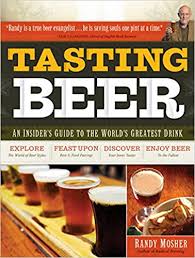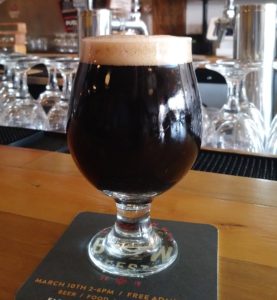One of the areas of “beer knowledge” I am learning about as I prepare for my Certified Cicerone® exam has to do with aroma and how we perceive flavors. The wide variety of flavors found in beer is one of the great delights in studying (i.e., consuming) beer and to really get the full sensory experience of beer, one needs to understand exactly what is happening to your taste buds when you sip on a cold one.
 In short, the human olfactory system is comprised of two sub-systems: the orthonasal system–which detects smells through your nose–and the retronasal system–which detects aromas around the back of the tongue and throat. When you put them both together, you get the wonder that is flavor. Beer author Randy Mosher spends quite a bit of time in Tasting Beer discussing the olfactory system and how flavor is experienced. [One would expect that in a book called “Tasting Beer.”]
In short, the human olfactory system is comprised of two sub-systems: the orthonasal system–which detects smells through your nose–and the retronasal system–which detects aromas around the back of the tongue and throat. When you put them both together, you get the wonder that is flavor. Beer author Randy Mosher spends quite a bit of time in Tasting Beer discussing the olfactory system and how flavor is experienced. [One would expect that in a book called “Tasting Beer.”]
I got a vivid lesson in orthnasal and retronasal flavors recently at Oro Brewing in Mesa.
Over the last year or so, I’ve grown fond of hoppy beers. Oro Brewing regularly features a single hopped Pale Ale, which they cleverly call “Singularity.” On a recent visit, I tasted a Citra version of the Singularity. I tend to  enjoy more fruit-leaning hopped beers and the Citra Singularity was recently released so I had to try it. It came to me quite cold and as I sniffed it, I got a slightly tropical, bright citrus aroma. The cold often accentuates the flavor–to me, a cold beer just smells better. As I drank it, I noticed that the citrus hoppiness didn’t linger too long, but it was a good brew so I didn’t care much.
enjoy more fruit-leaning hopped beers and the Citra Singularity was recently released so I had to try it. It came to me quite cold and as I sniffed it, I got a slightly tropical, bright citrus aroma. The cold often accentuates the flavor–to me, a cold beer just smells better. As I drank it, I noticed that the citrus hoppiness didn’t linger too long, but it was a good brew so I didn’t care much.
As I worked through the Singularity, I overheard Nick, the bartender at Oro recommend the “Give Peat a Chance” smoked peat Extra Stout to another patron, saying “it’s the best beer on tap right now.” I had to see what that was all about. Finishing the Singularity, I ordered a shorty of the Peat and I immediately began to understand why writers like Mosher make a big deal about aroma and olfactory systems and use confounding terms like “retronasal.”
The Peat had a very slight roasted aroma, but I had to really work at it to detect any at all. This was unlike other stouts I’ve had where the roasted elements stand out boldly. This was incredibly subtle, even with the very prominent foam. Likewise, as I sipped it, I noticed there was very little flavor on the tongue. My first reaction was “how can this be the best beer on tap right now? There’s nothing to this!” As I swallowed, I was immediately met with a  wave of flavor–smokey roasted malts with a little sweetness. I was shocked…where did THAT come from? As I pondered what was happening, I noticed the flavor lingering and getting stronger–a little more smoke, a little more dryness. The flavor from just the first sip seemed to last five minutes.
wave of flavor–smokey roasted malts with a little sweetness. I was shocked…where did THAT come from? As I pondered what was happening, I noticed the flavor lingering and getting stronger–a little more smoke, a little more dryness. The flavor from just the first sip seemed to last five minutes.
As I continued to ponder this (and taste the Peat again and again), I realized I was experiencing a lesson in orthonasal and retronasal flavor perception. The Singularity‘s flavor was largely dependent upon orthonasal factors–the aroma on the nose–and the Peat‘s flavor drew upon on the retronasal system–back of the tongue and back of the throat. Both beers, coming from the same brewer, created wildly diverse and strong flavor experiences. That’s what I love about beer!
Prost!
